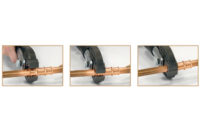A common domestic refrigerator consists of medium and low temperature sections. The challenge for the system designer is to find cost-effective solutions to properly control the temperature and humidity for both sections in an efficient manner.
The simplest approach from a refrigeration system design perspective is to use a single evaporator coil. The air that is blown across the evaporator is then directed as needed to one or both sections to maintain desired temperature. This approach is generally not as efficient as a two-evaporator system, and it produces less than desirable humidity control in the medium temperature section by supplying combined air flow to each section.
A two-evaporator system provides each section with its own evaporator coil. The evaporators may be piped in series or in parallel. Figure 1 shows evaporators in series. The series arrangement offers the option of using only one capillary tube to control refrigerant flow. A parallel arrangement will obviously require each coil to have its own capillary tube. A two-evaporator system offers numerous benefits over a single evaporator. It allows the designer to size the coil surfaces and their capillary tube to more optimally refrigerate each section. It also allows air flows to be separated which can help improve humidity control and reduce defrosts.
Having two evaporators active whenever the compressor is running does not necessarily resolve the issue of humidity control in the medium temperature section. In addition, there remains the problem of controlling temperatures in both sections. Two approaches can be considered to address these issues. The first approach is to raise and/or regulate evaporator pressure in the medium temperature evaporator. This reduces the temperature difference (TD) between the entering air and refrigerant temperatures which reduces the moisture removed from the air. The second is to either switch or modulate refrigerant flow into each of the evaporators. Depending on the configuration, this type of control could be used to bypass either evaporator when it doesn’t need to be active.
Raising evaporator pressure can be done simply by placing an appropriately sized orifice at the outlet of the medium temperature evaporator. The problem with this approach is an orifice does not regulate evaporator pressure. It can only raise evaporator pressure by the pressure drop it creates. To properly regulate evaporator pressure, an evaporator pressure regulating (EPR) valve may be used. The EPR can be a mechanical valve in which case the valve is manually set to the pressure it is to control. An electric EPR can also be considered which allows for electronic control, but its controller would also require a pressure transducer to measure pressure. Regulating evaporator pressure is generally not the most cost effective solution to improving refrigerant flow control for a domestic refrigerator.
Fortunately, electrically actuated valves that can either switch or modulate flow to each of the evaporators are available and provide cost-effective solutions. Figure 2 shows a three-way solenoid valve that controls refrigerant flow into either the medium or low temperature evaporator that are piped in series. Note this control requires evaporators piped in series to have their own capillary tube. When evaporators are piped in this manner, the control bypasses the medium temperature evaporator when called to do so. The low temperature evaporator remains active any time the compressor is running. If evaporator coils are piped in parallel with this control, only one evaporator is active at any time while the compressor is running. Since this control completely switches refrigerant flow in one of two directions, it works best when the system has relatively long response times, which is typical with domestic refrigerators.
The three-way solenoid valve featured in figure 3 employs a bi-stable coil which only requires electrical power to shift. This type of solenoid valve is also referred to as a latching solenoid valve, and provides energy savings due to the fact the coil doesn’t need to remain energized in either of the solenoid valve’s two positions. Solenoid coils of this type employ a permanent magnet. When the valve plunger is lifted by the magnetic field, it attaches to the permanent magnet. The valve plunger remains in position without the need for further electrical power. Applying reverse polarity to the coil releases the plunger from the permanent magnet.
In the situation where the system designer desires to regulate flow into three different evaporator coils, the three-way solenoid valve can be connected in series with another. Figure 4 shows two medium temperature evaporators piped in parallel to service two sections operating at different temperatures. These evaporators are controlled by one three-way valve. The medium temperature evaporators are piped in series with the low temperature evaporator which is then controlled by a second three-way valve. The second three-way valve bypasses the medium temperature evaporators when called to do so. The first three-way valve can switch flow between the two medium evaporators when the second three-way valve is not bypassing these coils.
An enhancement of this three-way valve is shown in figure 5. Instead of using a solenoid coil, this version uses a unipolar step motor which allows it to modulate refrigerant flow between its outlet connections. The advantage of a modulating three-way valve is clear. The step motor is operated by 12-volt DC pulses that come from the system control board which positions the rotor and cam within the valve to provide desired refrigerant flow.
This step motor version changes refrigerant flow and temperature control from a pulse-width modulating (PWM) approach to one that provides proportional control. The evaporator coils do not need to be just active or not active. They can be partially active with this control, allowing for improved temperature and humidity control and system efficiency. It also provides domestic refrigerators with shorter response times with improved control.






